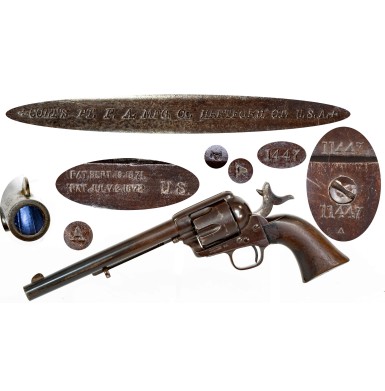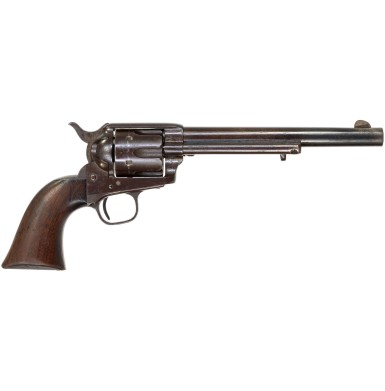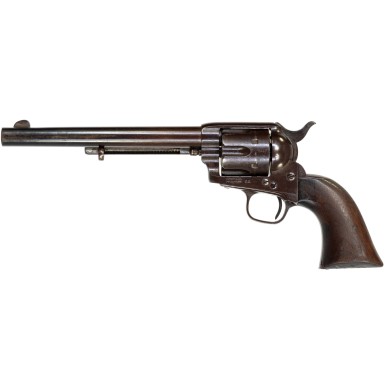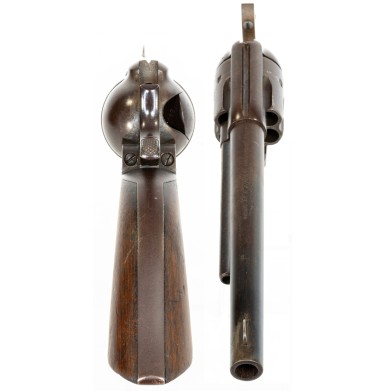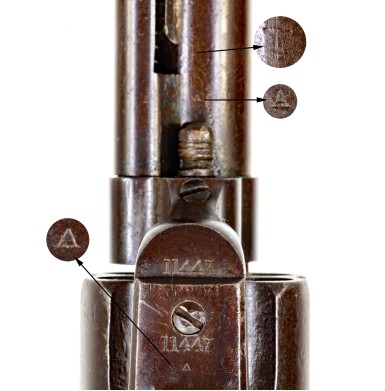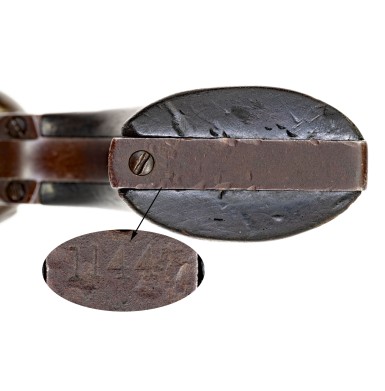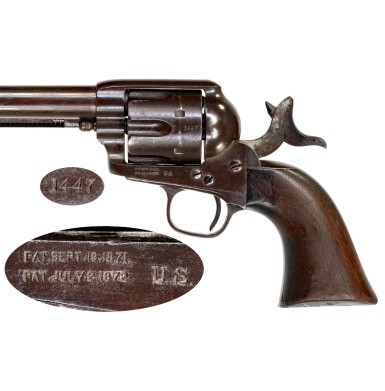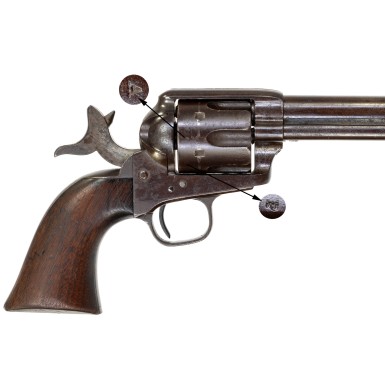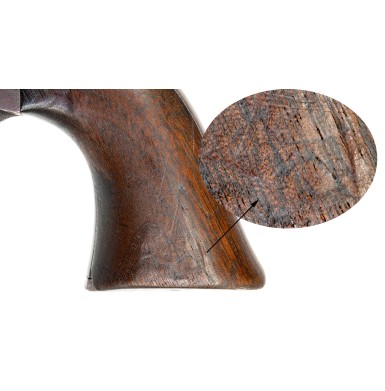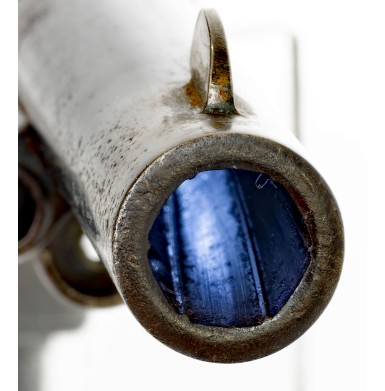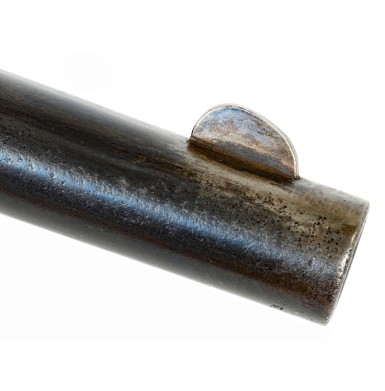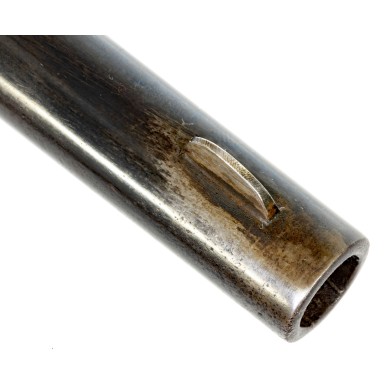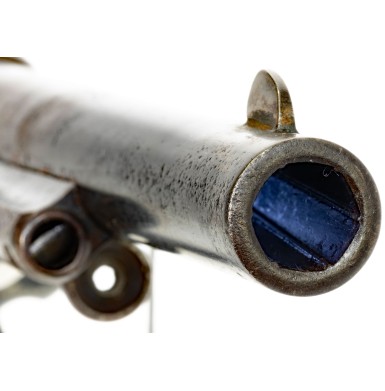Ainsworth Inspected Cavalry Single Action Army Revolver
- Product Code: FHG-3522
- Availability: Out Of Stock
-
$0.00
There is probably no more iconic handgun silhouette in American history than that of the Colt Single Action Army. The Model 1873 Revolver, known alternatively as the Model P, “Peacemaker” and by a variety of creative nicknames, was the final result of nearly a decade’s worth of effort by Colt to bring the next generation of handguns to the US military. The success of repeating, self-contained metallic cartridge firearms during the American Civil War, such as the Spencer Rifle and Carbine, as well as the Henry Rifle, had clearly foreshadowed the end of the age of percussion firearms. Almost from the moment the Civil War ended, the US Ordnance Department began looking for the next generation of cartridge firearms. The development of a cartridge conversion system for the existing stock of single shot, muzzle-loading muskets by Springfield Master Armorer Erskine S. Allin solved the problem of cartridge long arms for the Army temporarily, and eventually led to the introduction of the US Model 1873 “Trapdoor” series of long arms. However, the solution for the handgun problem was more complicated.
Smith & Wesson owned the rights to Rollin White’s “bored through cylinder” patent, making the production of conventional metallic cartridge revolver impossible without coming to some sort of royalty payment arrangement with Smith & Wesson. The patent would not expire until April of 1869, so until that point most firearms companies had their hands tied. In 1868, in order to get into the game a little quicker, Remington agreed to pay royalties for the rights to use the bored through cylinder patent in the alteration of percussion Remington handguns to metallic cartridge. Remington submitted several cartridge conversion samples for the US military handgun trials in 1869. However, it was Smith & Wesson who received the first US military contract for a cartridge revolver design.
In 1870 the US military ordered 1,000 Smith & Wesson Model No. 3 “1st Model” American Revolvers, chambered for the .44 S&W American cartridge. These guns with their top break design and automatic extraction system would become the basis for the later Model 1875 “Schofield” revolver. Colt was not out of the running however, and Springfield Arsenal altered about 1,200 existing Colt Model 1860 Army revolvers from percussion to .44 Colt via the Colt Richards Conversion system in early 1871. Initially these proved satisfactory but were still not as durable as the Remington Army revolvers, whose frames included a top strap for additional strength. During this time, Colt was working on what they were referring to as their “strap pistol” in house. This revolver included all of the best features from the Richards and Richards-Mason conversion, the Model 1871-72 “Open Top” and some new features like a frame with a top strap and a newly designed loading gate.
In late 1872 this new revolver was submitted for trials to the US Ordnance Department, chambered in the .44 S&W Russian Cartridge. Colt assumed that since the .44 Russian was a superior cartridge to the .44 S&W American, that the Ordnance Department would prefer that chambering. But in reality, the Ordnance Department intended to test the new Colt handgun against the Smith & Wesson Model 1870. Since the Smith & Wesson was chambered for .44 S&W American, the Colt needed to be chambered for that cartridge as well. After thorough testing by the US military, some recommendations, and minor modifications and improvements, the new Colt Revolver was officially accepted for military service as the Colt Model 1873 Revolver.
The Colt Model 1873 Revolver was a single action, six-shot revolver with partially fluted cylinder, a 7 ½” barrel, and was chambered for the newly developed .45 Colt cartridge. This new cartridge pushed a 250 grain, .454” diameter lead bullet at about 950 ft/s, with a muzzle energy of about 520 ft-lbs. The stopping power of this cartridge would become the gold standard of 19th century combat handguns and would be the benchmark for the .45 ACP cartridge, adopted in 1911, which is nearly the ballistic equivalent of the .45 Colt. The barrel of the revolver was rifled with 6 narrow lands and wide grooves that made one turn in 16” with a lefthand twist. The gun had a solid frame with a topstrap. A hinged loading gate on the right side of the frame was used for loading and unloaded cartridges and a spring tensioned ejector rod was mounted on the lower right side of the barrel. The revolvers were blued, with color case hardened frames and hammers. The one-piece walnut grips were oil finished. A screw entering from an angle at the bottom front of the frame retained the cylinder arbor pin. This feature would become known to collectors as the “black powder frame” as the screw retention system would not be abandoned until the dawn of the smokeless powder era, when a spring-loaded cross pin would finally replace the screw. Even though these revolvers were manufactured with mostly interchangeable parts that would require little, if any, fitting to exchange between guns, they were inevitably serial numbered on all of their major components, just like their Civil War era, less interchangeable brethren had been.
These 7 ½” barreled US martially marked Single Actions have acquired the collector’s name “Cavalry Model” to differentiate them from other variants of the Single Action Army. Colt accepted their first contract on 23 July 1873. The contract was for 8,000 revolvers and deliveries began on September 2 of that year, running through March of 1874. Over the next sixteen years, some 37,060 Single Action Army revolvers would be purchased from Colt by the US military, with the final deliveries taking place in April of 1891. During this sixteen-year period a number of small changes took place on the revolvers, mostly affecting the style, placement, and content of various markings. Some very minor cosmetic changes occurred during the transition from the 1st contract to the 2nd contract, such as increasing the bevel at the front of the cylinder, beveling the ejector housing tip, and increasing the size of the cylinder stops. These changes, however, are only really relevant when discussing the earliest guns delivered by Colt, as these features were standard by the time the 2nd contract was accepted.
A US military civilian arsenal sub-inspector and an accepting officer from the US Ordnance Department would inspect all of these military guns. The sub-inspectors were civilian employees of Springfield Arsenal, but the receiving officer was a US Army officer assigned to the Ordnance Department. Over the years, collectors have classified the Colt Cavalry Models by the name of the sub-inspector, whose initials appear on most of the major components of the revolvers and in a cartouche on the right side of the grips (with the exception of the Ainsworth cartouche that appears on the left side of the grip). The first group of 8,000 revolvers are the most prized Cavalry Models and are known by their sub-inspector Orville W. Ainsworth. The guns from this first contract were inspected with small, single letter inspection marks, as Colt revolvers had been during the Civil War. This system was subsequently changed to the use of all three of the inspector’s initials to avoid confusion between Colt-applied in-house inspection marks and military inspection marks. It was also to prevent confusion when an inspector with a last name that started with a “C” (like A.P. Casey) used only one letter, as it could be confused for a condemnation mark, rather than an acceptance mark. In addition to requiring the use of a full set of sub-inspection initials, the old system of placing two cartouches on the guns returned, with the sub-inspector marking the right side of the grip and the accepting officer marking the left side. The year of acceptance was also added above the accepting officer’s cartouche. The early inspection marking system is typically found on revolvers under serial number 19,500 and the improved system was in full force by about serial number 30,000 (although there are some exceptions in the 47,000-50,500 range – See Graham, Kopec & Moore for more information). Other inspectors that are regularly used to identify Cavalry Single Action Revolvers are John T Cleveland (circa 1876-1877, serial number range 30,693-35,569), Henry Nettleton (circa 1878, serial number ranges 36,798-39,703 & 47,056-51,083), David F. Clark (circa 1880-1886, serial number ranges 41,033-43,300 & 53,006-121,238) and Rinaldo A. Carr (circa 1889-1891 serial number range 130,438-140,361). I am indebted to A Study of the Colt Single Action Army Revolver by Graham, Kopec & Moore for the detailed information regarding the years and serial number ranges for the various sub-inspectors who viewed these Colt revolvers.
In all, the Ordnance Department would procure some 37,060 Colt Single Action Army Cavalry revolvers between 1873 and 1891. In 1895 a process of refurbishing and upgrading the revolvers in service began, creating what collectors have termed the “Artillery” Model revolvers. These were 7 ½” barreled cavalry revolvers that were refurbished, refinished, and often had their barrels shortened to 5 ½” in length. The first revolvers to be so transformed were 2,000 that were returned to Colt between 1895 and 1896 for the full restorative treatment and were returned good as new with 5 ½” barrels. It appears that most of these guns came back from Colt with their serial numbers matching. In 1898, some 14,900 of the guns were reconditioned at Springfield Arsenal, where they were reassembled without any effort to match components and serial numbers and were returned to the field with 5 ½” barrels as well. Between 1901 and 1902 2,600 guns were returned to Colt for refurbishing, but these guns were noted to have already been altered to the shorter 5 ½” barrel length. It is probable that these were revolvers that had seen service during the Spanish-American War, either in Cuba or the Philippines, where the harsh climate had taken its toll on their condition. The final group of guns to recondition and shortened to 5 ½” were another 2,600 that were sent to Colt in 1903. In all at least 19,500 Colt Single Action Army “Cavalry” revolvers were altered from 7 ½” barrels to 5 ½” barrels between 1895 and 1903, which is slightly more than half of the total acquisition of this model by the Ordnance Department. This explains why it is rather difficult to find original, unaltered Cavalry Model revolvers today with matching numbers and their original 7 ½” barrels. Even though the Model 1873 was officially replaced in 1892 by the Colt Model 1892 double action revolver in .38 Long Colt, the anemic stopping power of this cartridge meant that the Model 1873 remained in limited use as a “substitute standard” handgun until the adoption of the Colt Model 1911 .45 ACP semi-automatic pistol. The success and popularity of the Colt Single Action Army is probably only eclipsed by the success of the Colt Model 1911.
Slightly less than 358,000 Single Action Army revolvers, in all variants, were produced by Colt from 1872 through 1940, with production picking up again in 1955 with some 59,000+ produced before these “2nd Generation” guns went out of production in 1970. The Single Action Army remains a part of the Colt production line today and has been copied by many gunmakers around the world, a testament to the success of the design and its overall popularity. However, no modern incarnation of the classic Colt revolver is as historic or collectible as the original 7 ½” “Cavalry” Model 1873 Single Action Army, delivered to the Ordnance Department between 1873 and 1891.
Offered here is a VERY GOOD example of a US Military 7 ½” “Cavalry” Model 1873 Single Action Army Revolver, inspected by the most desirable of the Colt sub-inspectors, Orville W Ainsworth. Ainsworth inspected a total of 12,500 Single Action Army revolvers from the original government contract for 8,000 guns in July of 1873 through the first three contract extensions given to Colt between April and November of 1874, with each extension adding an additional 2,000 guns. He became too ill to continue his work on the November 1874 contract extension and the balance of the guns inspected under that contract were inspected by Captain Ramsay of the Ordnance Department, using Ainsworth’s dies and marks. Ainsworth inspected at the Colt factory between October 1873 and early November 1874, when he left the job due to sickness. During his tenure he is credited with inspecting the government contract Single Action Army Revolvers between serial numbers 182 and 14,998. The extreme desirability of Ainsworth inspected guns is that they were the earliest guns delivered and the guns from the first contract for 8,000 revolvers were the ones that were issued to Colonel George Custer’s 7th Cavalry from delivery lots 5, 6 and 7.
As the arsenal sub-inspector assigned to the Colt factory during this time, Ainsworth inspected every contract revolver in detail until he left the job on November 7, 1874. This was during the early inspection period when single letters were in use by the sub-inspectors rather than the three-letter system that would be adopted in the latter part of 1876. During this period Ainsworth only applied his small letter “A” to the various component parts that he inspected, in addition to his script OWA cartouche to the left grip. As noted above, no receiving officer cartouche was applied to these early Single Action Army deliveries.
This Ainsworth inspected Colt Model 1873 Single Action Army Revolver is serial number 11447 and was produced in the latter part of 1874, with most Colt serial number lists claiming that 1874 production began at approximately serial number 200 and ran through roughly 15,000. After looking all of the resources at my disposal for martial Single Action Army serial numbers, the closest numbered example I could find was #11416. That gun was in the field and in the possession of Company C 8th Cavalry in 1876. As the gun was not altered to the “Artillery” configuration it seems likely that it ended up in the inventory of a state militia. Revolvers #11441 and #11445 were both in the inventory of the New York State Militia, allowing them to escape 1893 field recall of the revolvers that began the rebuilding process and the alteration to “Artillery” models.
The complete, matching serial number 11447 appears on the triggerguard, frame, and bottom of the grip strap, with the abbreviated serial number 1447 (the last four digits) appearing on the side of the cylinder and on the barrel under the ejector housing, which must be removed to see it. The number also appears in period ink in the gripstrap cut out of the walnut grip, although it is weak. The loading gate is assembly numbered 830, and this number should not match the serial number of the gun as it is an assembly number. The bottom of the barrel, forward of the cylinder arbor pin is marked with the expected tiny A sub-inspection mark and a tiny P proof mark. The A mark also appears on the bottom of the triggerguard below the serial number, on the upper rear of the backstrap below the hammer mortise cut, and on the side of the cylinder. The cylinder also has a P proof mark as well. There is no “A” on the frame, which is correct for Ainsworth inspected Single Action Army revolvers. The lower left side of the frame is marked with the correct two-line, two patent date markings:
PAT. SEPT 19. 1871
PAT. JULY. 2. 1872
and with the military ownership and inspection mark U.S. stamped to the rear of the patent dates. The barrel is marked with the 1st type barrel address, found on Colt Single Action revolvers with barrels 5 ½” long or longer from about serial number 2,000 through about #19,500. This is referred to as the “script” address by Kopec and is italicized. The address reads in a single line:
+ COLT’S PT. F. A. Co. HARTFORD. CT. U.S.A.+
As is correct for this address, the upper right, angled arm in the letter “A” in “Hartford” is weak. Additionally, the lower right serif in the “T” in “PT” is intact, a part of the die that was broken by serial number 17,610 and probably at least a couple of thousand numbers before that. The ejector rod housing is the first pattern with the locating boss stud, and corresponding recessed hole in the barrel to assure correct alignment. This pattern of ejector housing was used through about serial number 16,800. As is correct the ejector rod head is of the “bullseye” style. These early ejector rod housings showed a minimal bevel to assist in holstering the gun and at least some known examples, like this one, show some irregular beveling that was likely applied either at Springfield Arsenal or possibly in the field to alleviate the problem. The cylinder has the correct, short stop notches measuring nominally 3/16” in length with essentially no lead in guide. At some time around serial number 17,000 these notches were lengthened to nominally ¼” and the lead in notch bevels were increased to nominally 3/16”. The cylinder face also shows the small, minimal bevel between the flutes of the earliest production guns. At about the same time the cylinder notches were enlarged, the cylinder bevel was increased as well. The hammer spur shows the correct style, nominally 19/32” long section of deep cross hatching. The firing pin is of the cone-shaped military and early civilian style. All of the markings in the metal of the gun remain relatively crisp, clear, and legible. There is no visible cartouche or sub-inspection on the grips.
As mentioned, the gun is in VERY GOOD condition overall and is a relatively crisp and very pleasing example of an original 7 ½” Cavalry Single Action Army Revolver. The gun retains only the most minor traces of original finish and otherwise had a thickly oxidized thick brown patina. There are some tiny flashes of blue in the recess between the side of the barrel and the upper portion of the ejector rod housing, on the reverse side of the housing and some nice blue is still present under the barrel where the ejector rod housing has protected it. Otherwise, the metal shows a thick brown patina with scattered surface oxidation, some freckled patches of surface roughness, some small areas of light pitting and some minor erosion on the frame forward of the cylinder chambers and forward of the forcing cone. The only restoration that appears to have been done to the revolver is building up the front sight blade to restore it. For whatever reason, many of the surviving Cavalry Single Action revolvers that still retain their full-length 7 ½” barrels have front sights that were either filed down to a lower profile or that have been restored in modern times to their original height. My theory about these is that most of the guns that never went through the “Artillery” rebuilding program were militia guns that stayed in service into the early 1900s. As the ammunition improved during the end of the 19th century and particularly as smokeless powder cartridges began to see use, I feel that the front sights had to be lowered in order to keep the point of aim and point of impact of the new ammunition consistent. Otherwise, the improved ammunition probably hit several inches higher than point of aim. The restoration of the front sight blade has resulted in the removal of some of the patina on the barrel in that area.
The action of the revolver remains in FINE condition and the revolver functions crisply and correctly on all positions. The revolver times and locks up perfectly and remains nice and tight. The loading gate functions smoothly and locks tightly into place and the ejector rod operates smoothly as well. The bore of the revolver rates about VERY GOOD as well and is partly bright with some moderate oxidation and frosting. It retains crisp black powder rifling with correct style narrow lands and broad grooves. Endoscopic examination of the bore with a camera reveals no indication that the barrel has been stretched or altered in way. The original, oil finished, one-piece walnut grip remains in about GOOD condition. As noted above, grip is numbered to the gun in the backstrap cut out, although the period applied ink number is somewhat weak. Unfortunately, the grip has been sanded and no longer retains any cartouche or sub-inspection marks, although there may be a shadow of upper rear edge of the cartouche’s box on the left grip. The grip shows moderate wear, and some chipped loss at the lower leading edges. The grip also shows a moderate number of minor dings, dents, mars and impact marks.
Overall, this is an attractive, essentially untouched example of an Ainsworth Inspected Colt Single Action Army US Cavalry Revolver. Ainsworth inspected guns are the most desirable of the Indian Wars era Single Action revolvers as they were all in the field in time for the biggest campaigns of the US Cavalry against the Native Americans. Sadly, the grip does not retain a cartouche, and the front sight has been restored. However, on a gun like this, the presence of a decent cartouche would easily add $2,000 to $3,000 to its price. If you have ever wanted the opportunity to own an “Ainsworth Single Action” and were put off by the prices that normally start in the low 5-figure range and can climb to the mid-six figure range for a gun with exceptional provenance, this would be a nice acquisition that allows you to fill that hole in your collection without crossing that 5-figure threshold.
ON HOLD/LAYAWAY
Tags: Ainsworth, Inspected, Cavalry, Single, Action, Army, Revolver

